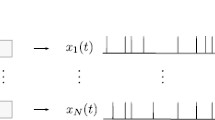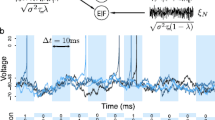Abstract
The mutual information between a stimulus signal and the spike count of a stochastic neuron is in many cases difficult to determine. Therefore, it is often approximated by a lower bound formula that involves linear correlations between input and output only. Here, we improve the linear lower bound for the mutual information by incorporating nonlinear correlations. For the special case of a Gaussian output variable with nonlinear signal dependencies of mean and variance we also derive an exact integral formula for the full mutual information. In our numerical analysis, we first compare the linear and nonlinear lower bounds and the exact integral formula for two different Gaussian models and show under which conditions the nonlinear lower bound provides a significant improvement to the linear approximation. We then inspect two neuron models, the leaky integrate-and-fire model with white Gaussian noise and the Na–K model with channel noise. We show that for certain firing regimes and for intermediate signal strengths the nonlinear lower bound can provide a substantial improvement compared to the linear lower bound. Our results demonstrate the importance of nonlinear input–output correlations for neural information transmission and provide a simple nonlinear approximation for the mutual information that can be applied to more complicated neuron models as well as to experimental data.






Similar content being viewed by others
Notes
There is a strong similarity of the observed maximum of the spike count vs mean signal to a standard problem in statistical physics: the giant acceleration of diffusion in a tilted periodic potential (Reimann et al. 2001; Lindner and Sokolov 2016). A Brownian particle in an inclined washboard potential attains a pronounced maximum in its positional variance [quantified by the diffusion coefficient, \(D=\lim _{T\rightarrow \infty } \langle (x-\langle x\rangle )^2\rangle /(2T)\)] for a certain intermediate value of the bias force [equivalent to the mean signal in the LIF model]. The maximum is attained for a force (mean signal strength) close to the bifurcation value that determines the transition from a noise-induced transport (or firing) regime to a regime, in which movement (spiking) is possible without noise.
References
Aldworth ZN, Dimitrov AG, Cummins GI, Gedeon T, Miller JP (2011) Temporal encoding in a nervous system. PLOS Comput Biol 7(5):e1002041
Bernardi D, Lindner B (2015) A frequency-resolved mutual information rate and its application to neural systems. J Neurophysiol 113(5):1342–1357
Bialek W, Rieke F, Vansteveninck RRD, Warland D (1991) Reading a neural code. Science 252:1854
Bialek W, Deweese M, Rieke F, Warland D (1993) Bits and brains—information-flow in the nervous system. Physica A 200:581
Borst A, Theunissen F (1999) Information theory and neural coding. Nat Neurosci 2:947
Brunel N, Nadal JP (1998) Mutual information, fisher information, and population coding. Neural Comput 10:1731
Burkitt AN (2006) A review of the integrate-and-fire neuron model: I. Homogeneous synaptic input. Biol Cybern 95:1
Chacron MJ, Doiron B, Maler L, Longtin A, Bastian J (2003) Non-classical receptive field mediates switch in a sensory neuron’s frequency tuning. Nature 423:77
Cover T, Thomas J (1991) Elements of information theory. Wiley, New York
Cox DR (1962) Renewal theory. Methuen, London
Doose J, Doron G, Brecht M, Lindner B (2016) Noisy juxtacellular stimulation in vivo leads to reliable spiking and reveals high-frequency coding in single neurons. J Neurosci 36(43):11120–11132
Droste F, Schwalger T, Lindner B (2013) Interplay of two signals in a neuron with heterogeneous short-term synaptic plasticity. Front Comput Neurosci 7:1
Gabbiani F (1996) Coding of time-varying signals in spike trains of linear and half-wave rectifying neurons. Netw Comput Neural Syst 7:61
Gammaitoni L, Hänggi P, Jung P, Marchesoni F (1998) Stochastic resonance. Rev Mod Phys 70:223
Grewe J, Kruscha A, Lindner B, Benda J (2017) Synchronous spikes are necessary but not sufficient for a synchrony code in populations of spiking neurons. PNAS 114(10):1977–1985
Izhikevich EM (2007) Dynamical systems in neuroscience: the geometry of excitability and bursting. The MIT Press, Cambridge
Juusola M, French AS (1997) The efficiency of sensory information coding by mechanoreceptor neurons. Neuron 18(6):959–968
Kraskov A, Stögbauer H, Grassberger P (2004) Estimating mutual information. Phys Rev E 69(6):066138
Lagarias J (2013) Euler’s constant: Euler’s work and modern developments. Bull Am Math Soc 50(4):527–628
Lindner B, Sokolov IM (2016) Giant diffusion of underdamped particles in a biased periodic potential. Phys Rev E 93(4):042106
Lindner B, Schimansky-Geier L, Longtin A (2002) Maximizing spike train coherence or incoherence in the leaky integrate-and-fire model. Phys Rev E 66:031916
Marmarelis PZ, Naka K (1972) White-noise analysis of a neuron chain: an application of the Wiener theory. Science 175(4027):1276–1278
McDonnell MD, Ward LM (2011) The benefits of noise in neural systems: bridging theory and experiment. Nat Rev Neurosci 12:415
Morris C, Lecar H (1981) Voltage oscillations in the barnacle giant muscle fiber. Biophys J 35:193
Neiman AB, Russell DF (2011) Sensory coding in oscillatory electroreceptors of paddlefish. Chaos 21:047505
Nemenman I, Lewen GD, Bialek W, de Ruyter van Steveninck RR (2008) Neural coding of natural stimuli: information at sub-millisecond resolution. PLOS Comput Biol 4:e1000025
Nikias CL, Petropulu AP (1993) Higher-order spectral analysis. PTR Prentice Hall, Upper Saddle River
Panzeri S, Schultz SR (2001) A unified approach to the study of temporal, correlational, and rate coding. Neural Comput 13(6):1311–1349
Panzeri S, Senatore R, Montemurro MA, Petersen RS (2007) Correcting for the sampling bias problem in spike train information measures. J Neurophys 98(3):1064–1072
Passaglia CL, Troy JB (2004) Information transmission rates of cat retinal ganglion cells. J Neurophysiol 91(3):1217–1229
Reimann P, Van den Broeck C, Linke H, Hänggi P, Rubi M, Perez-Madrid A (2001) Giant acceleration of free diffusion by use of tilted periodic potentials. Phys Rev Lett 87:010602
Ricciardi LM (1977) Diffusion processes and related topics on biology. Springer, Berlin
Rieke F, Warland D, Bialek W (1993) Coding efficiency and information rates in sensory neurons. Europhys Lett 22:151
Rieke F, Bodnar D, Bialek W (1995) Naturalistic stimuli increase the rate and efficiency of information transmission by primary auditory afferents. Proc Biol Sci 262:259
Rieke F, Warland D, de Ruyter van Steveninck R, Bialek W (1996) Spikes: exploring the neural code. MIT Press, Cambridge
Ryzhik IM, Gradshtein IS (1963) Tables of series, products, and integrals. VEB Deutscher Verlag der Wissenschaften, Berlin
Sadeghi SG, Chacron MJ, Taylor MC, Cullen KE (2007) Neural variability, detection thresholds, and information transmission in the vestibular system. J Neurosci 27(4):771–781
Shannon R (1948) The mathematical theory of communication. Bell Syst Tech J 27:379
Siegert AJF (1951) On the first passage time problem. Phys Rev 81:617
Stemmler M, Koch C (1999) How voltage-dependent conductances can adapt to maximize the information encoded by neuronal firing rate. Nat Neurosci 2:521
Strong SP, Koberle R, van Steveninck RRD, Bialek W (1998) Entropy and information in neural spike trains. Phys Rev Lett 80:197
Theunissen F, Miller JP (1995) Temporal encoding in nervous systems: a rigorous definition. J Comput Neurosci 2(2):149–162
Thomas PJ, Lindner B (2014) Asymptotic phase for stochastic oscillators. Phys Rev Lett 113(25):254101–5
Victor JD (2002) Binless strategies for estimation of information from neural data. Phys Rev E 66(5):051903
Victor JD (2006) Approaches to information-theoretic analysis of neural activity. Biol Theory 1(3):302–316
Vilela RD, Lindner B (2009a) Are the input parameters of white-noise-driven integrate and fire neurons uniquely determined by rate and CV? J Theor Biol 257:90
Vilela RD, Lindner B (2009b) A comparative study of three different integrate-and-fire neurons: spontaneous activity, dynamical response, and stimulus-induced correlation. Phys Rev E 80:031909
Voronenko SO (2018) Nonlinear signal processing by noisy spiking neurons. Ph.D. thesis, Humboldt-Universität zu Berlin, Berlin
Voronenko SO, Lindner B (2017) Weakly nonlinear response of noisy neurons. New J Phys 19(3):033–038
Voronenko SO, Stannat W, Lindner B (2015) Shifting spike times or adding and deleting spikes—how different types of noise shape signal transmission in neural populations. JMN 5(1):1–35
Acknowledgements
This work was supported by the BMBF (FKZ: 01GQ1001A) and the DFG (Research Training Group GRK1589/2).
Author information
Authors and Affiliations
Corresponding author
Additional information
Communicated by Peter J. Thomas.
Rights and permissions
About this article
Cite this article
Voronenko, S.O., Lindner, B. Improved lower bound for the mutual information between signal and neural spike count. Biol Cybern 112, 523–538 (2018). https://doi.org/10.1007/s00422-018-0779-5
Received:
Accepted:
Published:
Issue Date:
DOI: https://doi.org/10.1007/s00422-018-0779-5




